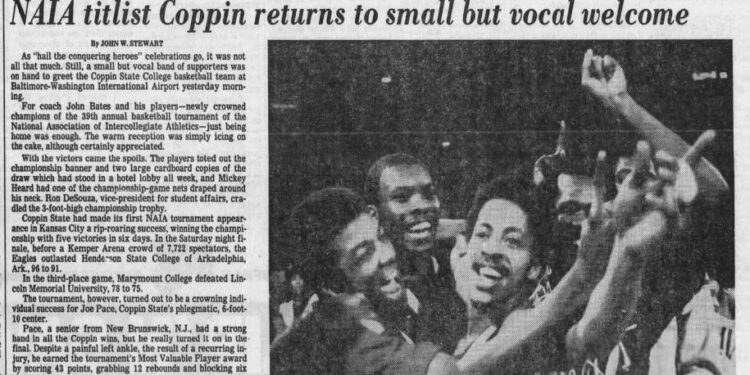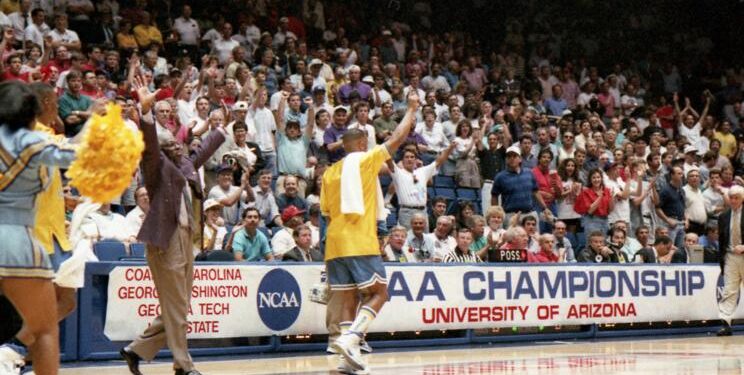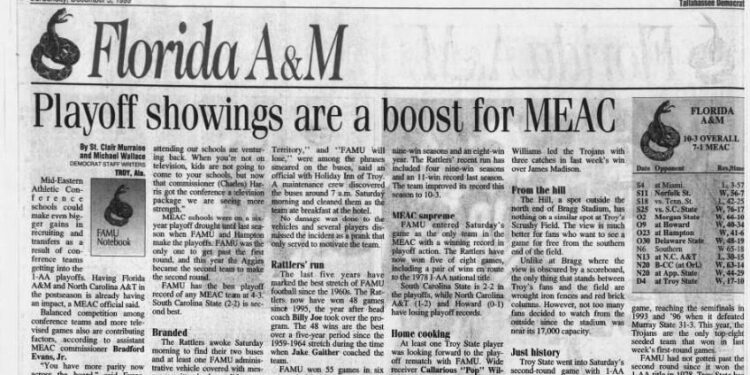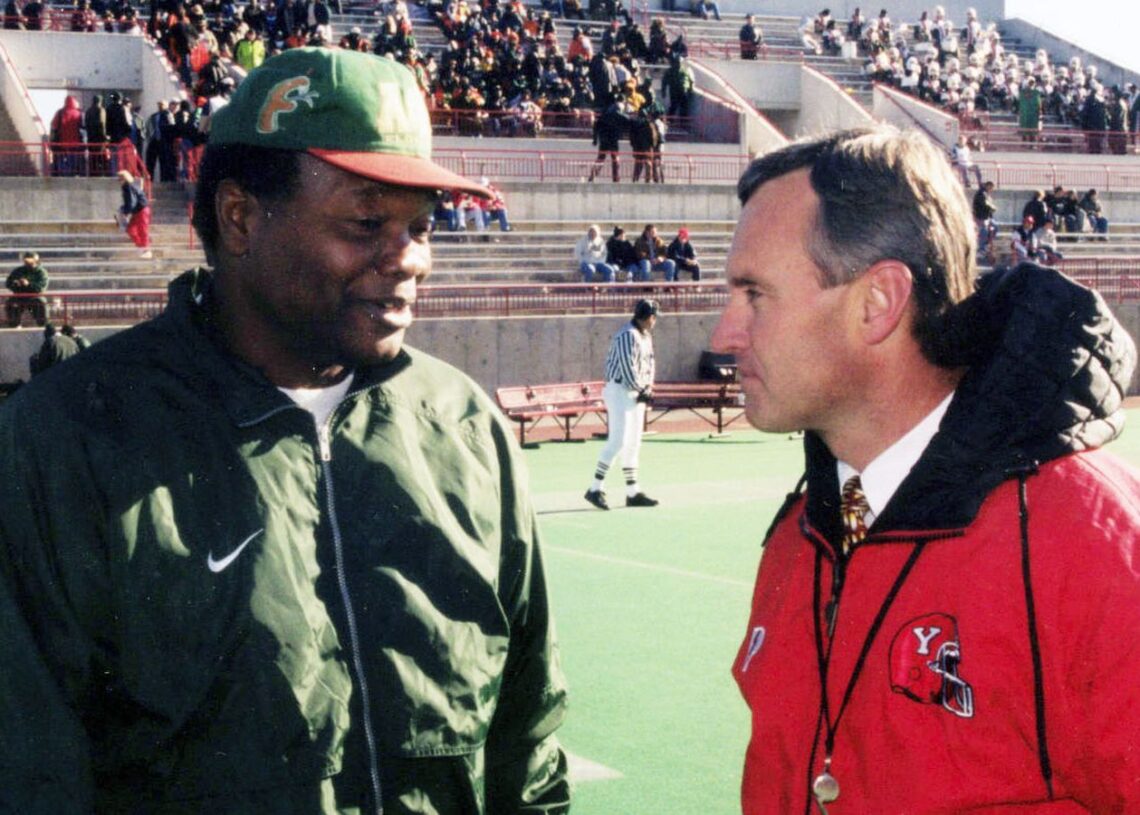The 1990s were arguably the most prosperous years the MEAC and SWAC had concurrently, thanks to several successful programs in football and basketball making names for themselves.
There were the usual suspects in a few instances, but one special case in West Baltimore would prove to be the quintessential HBCU sports success story.
Much like the MEAC began with an idea from seven Division II HBCUs, their newest member for the 1985-86 season joined with hopes of greener pastures and better athletic competition.
Coppin State College began life as Colored High School in 1900, then in 1926 took its current name from Fanny Jackson Coppin, the first Black school superintendent in the United States. Coppin Teachers College began conferring degrees shortly before World War II began and, by 1950, became a part of the Maryland Department of Education as Coppin State Teachers College. In 1967, as other degree programs were established on campus, the “Teachers” portion of the name was dropped.
The Eagles’ basketball program experienced early success in 1967, winning the Maryland Intercollegiate Conference title with a 13-7 record. Then by 1974, a new big man on campus would lead Coppin to higher heights. New Jersey native Joe Pace was a lanky 6-foot-10 center who could do just about a little bit of everything on a basketball court. He did just that for two years at Maryland State.
Alongside fellow future NBA player Talvin “Tab” Skinner, Pace helped the Fighting Hawks upset Marvin Webster and Morgan State in the 1974 MEAC championship game. Strangely enough, Morgan got an invite to the NCAA Division II tournament. At the same time, Maryland State had to settle for an invite to the NIT, where Pace and Skinner led over Manhattan College for the first NIT win in conference history.

Coppin State goes from humble beginnings to national prominence
Pace decided to transfer to Coppin State, and by 1976, the Eagles were in the NAIA national tournament as a No. 9 seed. Upsets across the country benefitted the Eagles greatly. Pace and his teammates defeated Texas Southern in the Elite Eight, then took down Marymount (Kansas) and Henderson State (Ark.) in the Final Four in Kansas City to win the national championship.
Pace scored 43 points, grabbed 12 rebounds, and swatted six shots in the 96-91 title game victory, earning Most Outstanding Player honors. Pace would go on to win an NBA championship in 1978, serving as a backup center to Wes Unseld and Elvin Hayes on the Washington Bullets.
When Coppin State joined the MEAC in the fall of 1985, they had some work to do.
The Coppin Center was still under construction, so home games were played at the Community College of Baltimore. Even under those circumstances, a change in leadership would occur the next fall. That change would bring the Eagles from humble beginnings to national prominence.
Ronald “Fang” Mitchell was a veteran junior college coach of eight seasons when he was hired at Coppin in 1986, fresh off four NJCAA Division II tournament appearances at Gloucester County College. Mitchell had a task ahead of him. In a conference where not many schools had that much of an advantage over the others, the Eagles were starting from the ground up and couldn’t be choosey.
Lucky for Coppin State, Fang, a Philly-born, Camden-raised battler who worked for everything he had, was able to convince players with similar backgrounds to join him.
“[The players] have to be taught responsibility in the classroom first,” Mitchell told Baltimore Sun reporter Bill Free shortly before the 1986-87 season began. “If they show discipline and responsibility in the classroom, it will carry over to the court.”
By the 1989-90 season, the Eagles were a force to be reckoned with in the MEAC, starting that season with a memorable 70-63 upset of Maryland at Cole Field House. The Terps were so embarrassed by the loss that it wasn’t until 2022 that the two schools played each other again.
Coppin blistered through the MEAC with a 15-1 regular season mark and defeated North Carolina A&T in the conference championship game to earn an NCAA tournament appearance. That Eagles team was led by Larry Stewart, who was in the middle of a dominant run as a two-time MEAC player of the year and three-time all-MEAC performer. Stewart would go on to play five seasons in the NBA with the Bullets and Seattle Supersonics before returning home as Coppin State head coach to begin the 2023-24 season.
While Coppin State was establishing itself as a MEAC basketball power, the conference was working on getting back into the hunt as a then-I-AA football contender.
By 1993, Howard University, under former Bison standout and NFL player Steve Wilson, put together a remarkable season led by quarterback Jay “Sky” Walker and wide receiver Gary “Flea” Harrell.
Howard finished the regular season 11-0 overall and 6-0 in MEAC play, earning an I-AA playoff invite and a daunting trip to Huntington, West Virginia, to play Marshall. The Thundering Herd were 7-1 in FCS playoff games up to that point.
Howard fell behind 14-0 early, but rushing touchdowns from Rupert Grant evened the score at 14 just before the half. Marshall took the lead for good with a late second-quarter touchdown and won 28-14. It was Howard’s first and, to date, only playoff appearance.
A breath of fresh ‘Air’ hits the SWAC
The SWAC in the 90s was also marked by a period of growth in football, especially with one special quarterback taking the country on a ride through the air.
The University of Florida offered Steve McNair a scholarship as a running back. But determined to play quarterback, he instead decided to play at Alcorn State University, and by his senior season of 1994, the buzz around “Air McNair” was reaching feverish proportions.
McNair threw for nearly 5,300 yards and rushed for 904 more, throwing 47 touchdowns and leading Alcorn to the playoffs against No. 1 Youngstown State. An injured hamstring limited his effectiveness as a runner. Still, even in a 63-20 loss to the eventual national champions, McNair hung tough, completing an obscene 52 of 82 pass attempts for 514 yards, an FCS playoff record.
That year, McNair would finish third behind Ki-Jana Carter and Rashaan Salaam in the Heisman voting.
Even with McNair’s success and the conference’s legendary status, the SWAC could not break through in the playoffs. In 19 appearances between five teams, the meeting could not win an FCS playoff game. And when faced with the reality of what it would take to be an FCS power, they changed course.
“It’s all about which is able to bring more revenue,” Alcorn State football coach Johnny Thomas told the Clarion-Ledger of Jackson, Mississippi, after the SWAC’s presidents agreed to divisional play and a conference championship game during their February 1999 meeting.
“We will profit more from the title game than we do the playoffs.”
The SWAC had expanded to 10 teams the previous fall with the additions of longtime rivals Alabama A&M and Alabama State from the SIAC. Arkansas Pine-Bluff returned to the SWAC in 1982 after leaving in 1970. While the SWAC gracefully bowed out from the national football championship chase, their basketball fortunes received a shot in the arm during the 1993 NCAA tournament.

HBCU hoops teams pull off memorable NCAA tournament bracket busters
Southern University was coached by Ben Jobe, who sat under the learning tree of John McClendon, widely recognized as the godfather of modern basketball. Jobe had taken the Jaguars to the Big Dance three times before, with standouts such as Avery Johnson and Bobby Phills leading the way. The 1993 Jaguars, however, were something of a surprise.
Finishing second behind Jackson State (featuring future NBA champion Lindsey Hunter) in the conference standings, Southern stunned the Tigers 101-80 in the conference championship game, earning a trip to the NCAA tournament and, for Coach Jobe, a reunion with an old friend.
In the 70s, Jobe was an assistant at the University of South Carolina, and one of his colleagues was a young and hungry kid from the Bronx named Bobby Cremins. Cremins was the head coach at Georgia Tech and had a who’s who of NBA players to his credit even then – Mark Price, John Salley, Kenny Anderson, and Dennis Scott, just to name a few.
All of that mattered little once the ball was thrown up in the air on March 19, 1993, in Tucson, Arizona.
The Yellowjackets did look the part of the ACC tournament champions in the early going, sprinting out to a 32-17 lead before Southern closed to within 44-39 at the half.
That’s when Jobe used the power of persuasion to get his guys ready for the second half.
“I told them to think of their best game of the year and try to duplicate that. I didn’t care if it was the waterboy; somebody had to step up,” Jobe said afterward.
Led by forward Jervaughn Scales’ 17-point second half (27 total), the No. 13 seed Jaguars rolled by No. 4 Georgia Tech 93-78, the SWAC’s first NCAA tournament win since Alcorn State 13 years earlier.
“If I were to lose to anybody, I’m glad it was to Ben Jobe,” Cremins said afterward. “He deserves this moment, and his team was fabulous.”

Coppin State would have its moment of NCAA tournament glory four years later.
The Eagles made two NCAA tournament appearances (1990, 1993) and two NIT appearances (1991, 1995) before the 1997 East Regional in Pittsburgh. As the 15th seed, they would go up against No. 2 South Carolina, led by the guard trio of B.J. McKie, Larry Davis, and Melvin Watson.
But the Coppin State duo of Danny Singleton and Antoine Brockington set the tone for the game’s outcome.
“I heard it all about their guards being All-SEC, but I told Coach I haven’t met a guard that could check me yet,” Brockington said after the game.”
Singleton and Brockton outscored McKie and Davis 42-31, along with 11 points from all-conference center Terquin Mott and 15 rebounds from forward Reggie Welch. Fang Mitchell’s decade of dedication and perseverance finally earned a deserved reward.
“When I took this job 11 years ago,” Mitchell said after the Eagles sent the Gamecocks packing 78-65. “My dream was to win an NCAA tournament game. I just watched my dream come true. And wasn’t it beautiful?”
For a school that didn’t have campus housing or even a home gym at the start of Mitchell’s tenure, Coppin State’s rise to men’s basketball prominence is one of America’s greatest sports stories. It’s even earned the documentary treatment – “On and Coppin” is currently streaming on ESPN+.
MEAC football breaks through in postseason play
As the ‘90s ended, the MEAC would have one final moment of playoff bliss on the football field.
North Carolina A&T and Florida A&M were head and shoulders above the rest of the conference during the 1999 season, with the Aggies besting the Rattlers 30-15 to win the conference title. Both teams, however, earned bids to the I-AA playoffs, and the Aggies would go on the road to face unbeaten Tennessee State, the tournament’s top seed.
Under head coach L.C. Cole, the Tigers went 11-0 in the regular season and 6-0 in the Ohio Valley Conference and came into the first-round game averaging 38 points and 455 yards of offense per contest.
That blazing Tigers offense never had a chance to get going.
NC A&T ran for 206 yards, winning the time of possession battle by a whopping total of 41:21 to 18:39. Reserve running back Adrian Parks scored a touchdown, Marcus Bryson caught another, and cornerback Temell Purkett fell on a blocked punt in the end zone to help the Aggies stun TSU 24-10.
“What an amazing run,” NC A&T head coach Bill Hayes said. “It was a big playoff win, our first one, to help us stay in the hunt.”
Meanwhile, about 340 miles east of Nashville, Billy Joe’s Rattlers jumped out to a big lead against Appalachian State, only to see the Mountaineers close to within seven points in the fourth quarter.
Fortunately, the Gulf Coast Offense had one more drive left in the tank, and after quarterback JaJuan Seider rumbled 15 yards for a touchdown, the Rattlers had booted ASU from the postseason in a 44-29 win.
The following week, NC A&T headed up to Youngstown State while FAMU visited No. 5 seed Troy State. Youngstown State had an easier time with the Aggies than Tennessee State did, coming away with a 41-3 victory. FAMU got a great performance from reserve quarterback Quinn Gray to upset Troy State 17-10. Gray relieved a cramping Seider and threw for 221 yards, including a 57-yard scoring toss to receiver Demetris Bendross for the winning points.
“Quinn was on top of his game,” Bendross told the Tallahassee Democrat. “He’s the type to sit in the pocket and gun them down.”

FAMU was one step away from the I-AA title game, which they had won 21 years earlier, becoming the first – and only – HBCU to win a Division I football title.
Unfortunately, it was not meant to be, as an 11-point fourth-quarter lead turned into a 27-24 triumph for Youngstown State in the national semifinals. It was a tough way to close out a great decade for the baby brother of the two DI HBCU conferences.
And it would be the swan song for MEAC playoff success.








